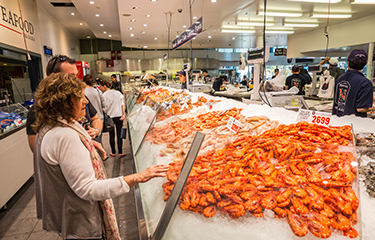Australian seafood prices climbed to record highs in the lead-up to the Christmas and New Year holidays due to continued effects from supply chain issues and labor shortages.
Prices for Australian seafood have been on a steady rebound since the onset of the Covid-19 pandemic. Demand increased 30 percent year-over-year in December 2021, and retailers said they were expecting strong sales once again in December 2022.
Sally and Phil Maher, the owners of Ballarat Seafoods in Victoria, Australia, told the Australia Broadcasting Network the price of salmon has increased as much as 30 percent over the past 12 months, with retailers and wholesalers purchasing product at some of the highest prices seen over the past three decades. The Mahers cited the effects of the pandemic, growing global demand, production costs, and foul weather for carrying salmon prices to as much as AUD 50.00 (USD 34.05, EUR 31.90) per kilogram recently, roughly double the average price from the month before.
Queensland Seafood Marketers Association President Ian Hamilton said while prices have risen, domestically-raised and -caught seafood still represents a good value for Australian consumers.
“Queensland prawn and fish prices remain competitive and good value. Consumers can expect to buy wild-caught Queensland northern kings from AUD 27.00 [USD 18.18, EUR 17.22] a kilo and a Queensland’s favorite large wild-caught tigers from AUD 35.00 [USD 23.60, EUR 22.32] a kilo. There are plenty of top-quality, well-priced farmed tiger and banana prawns too,” Hamilton said.
Rock lobsters, a holiday favorite for many Australians, “are plentiful,” Hamilton said, and were retailing for around AUD 65.00 (USD 43.76, EUR 41.45) per kilo.
“People are being spoilt for choice with Queensland tiger prawns, squid, [sand crabs], scallops, as well as prime table fish – red emperors, snappers, Sunshine Coast tuna and our own Queensland barramundi to choose from,” Hamilton said.
Prices for domestically-raised oysters – and particularly Sydney rock oysters, considered a special delicacy in Australia – have also risen, with many supplies decimated by flooding and a parasite outbreak in Port Stephens.
Despite the challenges, Seafood Industry Australia CEO Veronica Papacosta said local seafood was still widely available across the country over the holiday season.
“Across the entire food supply network, there has been impacts to the supply chain and labor shortages,” she said. “However, consumers don't need to worry – between our aquaculture and wild-caught products there will be a wide variety of Australian seafood available.”
Fred Harrison, the chief executive of Richies Stores, the largest independent supermarket chain in Australia, said the price of Australia salmon had risen from a range of between AUD 20.00 (USD 13.46, EUR 12.75) and AUD 30.00 (USD 20.20, EUR 19.13) to more than AUD 50.00 (USD 33.66, EUR 31.87), primarily due to lack of supply.
"It's not going to be until March or April that we'll see normal prices again," Harrison told the ABC. "There are warm waters down in [Tasmania], and fish aren't eating as a consequence; therefore, they grow slower. A shortage in volume escalates prices."
Harrison said the current salmon prices are the highest he’s ever seen.
"It's skyrocketed in the past 12 months," he said. "It's not profiteering. I know the salmon farms aren't having a good time at all. Unfortunately, it's just the reality of the market we're in at the moment."
Harrison said other species of fish had also increased in price recently.
"It's going to be expensive this Christmas. It's just the reality, unfortunately," he said in early December. "If you're having a seafood lunch this year, you might need to ration quantities, although prawns won't be too bad – prawns will be up a little bit, but maybe only a couple of dollars a kilo."
A study commissioned by the Marine Stewardship Council and carried out by YouGov found five million Australians indicated they planned to eat more prawns during the holidays. And 62 percent of seafood consumers said they would seek certified sustainable prawns.
The Fish Factory, a seafood shop in Brisbane, Australia, sold more than 15 metric tons of prawns through the holiday season, according to owner Andrew Solomon, as well as 500 kilograms of swimmer crabs and 350 kilograms of mud crabs.
“Australian prawns are abundant this year between our wild-catch and aquaculture operations,” Papacosta said. “Prawns are traditionally the biggest seller of the season. However, we are seeing rock lobsters and whole fin-fish like Tasmanian Atlantic salmon and barramundi rising in popularity as people opt for seafood over the traditional beef or lamb roast.”
Papacosta consumers can expect to pay between AUD 30.00 (USD 20.20, EUR 19.13) to AUD 35.00 (USD 23.57, EUR 22.32) for Western rock lobsters this year.
While eating local seafood has been a longstanding Australian holiday tradition, at least one Australian politician is warning the practice could soon disappear from the mainstream due to a number of management decisions, including the introduction of commercial net fishing bans in a few areas and a deep cut to Spanish mackerel quotas.
Senator Matthew Canavan, who represents the state of Queensland, said despite having the third-largest ocean reserves in the world and a relatively small population, Australia imports 70 percent of its seafood.
“Australia extracts 28 kilograms of seafood per square kilometer of ocean,” he wrote recently in an op-ed that appeared in Central Queensland Today. “China, Thailand, and Vietnam all have extraction rates almost 200 times higher, at over 5,000 kilograms of seafood per square kilometer."
Photo courtesy of Tooykrub/Shutterstock







